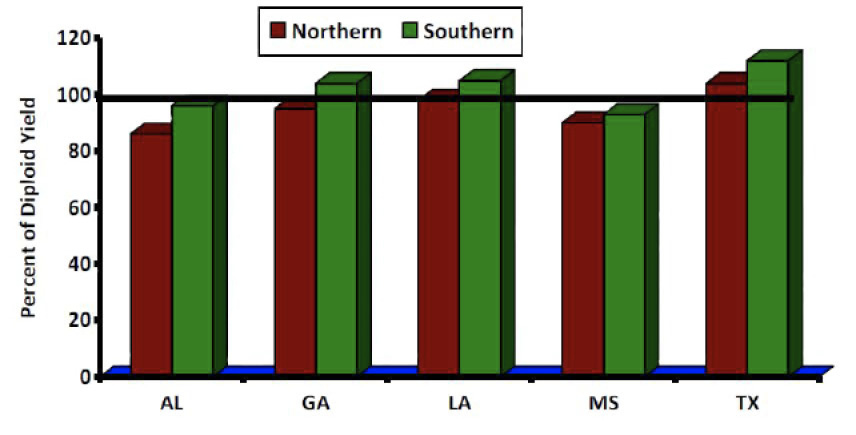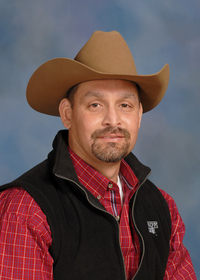Selecting an Annual Ryegrass Variety for Winter Grazing
Producers ask many questions before they plant winter annuals. They want to know what varieties to plant, which varieties will give the most for the money, and what to look for in a variety. Those are all important considerations. There are several traits that are important when selecting a variety. For example, it’s important to choose a variety that establishes quickly, is well-adapted to the area, yields plenty, yields consistently throughout the season, is very palatable, transitions easily back to warm-season grasses, resists disease, tolerates cold, and is reasonably priced.
The Mississippi annual ryegrass variety testing program provides information on performance traits and adaptation of different varieties of annual ryegrass. The tests are run over several years and across many locations statewide in an effort to find the varieties that are best adapted for each area. MSU research and Extension professionals develop variety recommendations based on these tests. Check these evaluations before you choose a ryegrass variety for a beef stocker program or any other livestock grazing management system. The trial results will help you select high-performance varieties that are productive during the desired season of use.
Seed quality is a very important factor when purchasing seed because it affects germination and establishment. Purchase premium-quality seed that has a high germination percentage and purity and is free from weed seed. We recommend buying certified seed or proprietary seed of an improved variety instead of common seed. Order seed well before the planting season for the best price. The later you wait to buy seed, the more expensive it will be.
You can use last season’s seed, but be aware that seed that has been stored improperly may show decreased seedling vigor. Also, pay close attention to when the germination test was done. If the test was done more than a year ago, get the seed retested. Use the information from the germination test to adjust the seeding rate. Contact your local MSU Extension office for information on seed testing.
Also consider using a Pure Live Seed (PLS) rate. To determine PLS, you must know the percent germination and the percent purity. That information should be in the tag of the certified seed (Figure 1). If not, contact your seed provider or co-op to get the information for the seed lot you purchased. First, multiply the germination and purity percentages. Next, divide by 100 to find the PLS. Here is one example: (95 percent germination × 80 percent purity)/100 = 76 percent PLS. Now that you know PLS, divide the desired seeding rate by this number to determine how much bulk seed you need. For example, if the PLS is 76 percent and the recommended seeding rate is 30 lb/ac, then the actual seeding rate needed is 39.5 lb/ac (30/0.76). Rate of PLS often varies among seed lots, even of the same variety.

1 To determine pure live seed (PLS), multiply the pure seed percentage by the germination percentage.
2 Percent pure seed, other crop seed, inert matter, and weed seed percentage should total 100 percent.
Pure Live Seed rate can also be used to determine the best seed buy. The amount you are paying per pound of seed must be adjusted according to PLS. You can divide the cost per pound of seed by the PLS to get the cost per pound of PLS, which is what you are really paying for. For example, if you are paying $0.44/lb, then the cost of PLS based on the example above is $0.58/lb ($0.44/0.76). Using this information, you can compare seed lots and varieties. These calculations can be especially helpful if cost is a major factor in determining how many acres you will plant. Sometimes the cheapest seed per pound is not the cheapest PLS per pound after all.
You may need to adjust the seeding rate according to the calculated PLS. Using the example above, if the recommended seeding rate was 30 lb/ac and you need 39.5 lb/ac to achieve the target rate, you would be roughly 25 percent under the target seeding rate if you planted 30 lb/ac. Annual ryegrass will germinate in 7 to 10 days with sufficient soil moisture, and having lower seed numbers per square foot will affect productivity and probably lead to more weed competition. Many times, purity and germination are high enough that a significant adjustment is not necessary. However, even seed with 90 percent purity and 90 percent germination contains 20 percent less viable seed than you think, so pay attention to PLS when you buy or plant seed.
Maturity of the variety is also important. Maturity is especially important when overseeding warm-season pastures. There are three categories of ryegrass based on when it matures: early, mid-, or later maturity (Table 1). Establishing winter annuals into bahiagrass is likely to be more difficult than establishing them into bermudagrass because bahiagrass is very competitive. Bahiagrass grows later into the fall than bermudagrass does and forms a tight root system due to the production rhizomes. Overseeding permanent grass pastures with winter annuals usually decreases the annual yield of the perennial grass to some extent as a result of shading and competition in spring. This is a concern with annual ryegrass because it grows so late into the spring. If you are overseeding permanent grass pastures with ryegrass, select an early or midmaturing variety, especially if the warm-season pasture produces hay.
|
Cultivar |
Type1 |
Maturity (flowering) |
Crown Disease Resistance |
Cold Tolerance |
|---|---|---|---|---|
|
Attain |
4n |
Late |
Resistant |
Low to Medium |
|
Beefbuilder III |
4n |
Early to Mid |
Resistant |
Medium |
|
Big Boss |
4n |
Early to Mid |
Resistant |
Medium |
|
Bigdaddy |
4n |
Mid to Late |
Resistant |
Medium |
|
Brigadier |
2n |
Early |
Resistant |
High |
|
Bruiser |
2n |
Late |
Resistant |
Medium to High |
|
Bulldog Grazer |
2n |
Early to Mid |
Resistant |
Medium to High |
|
Chipola |
2n |
Early to Mid |
Resistant |
Medium to High |
|
Corral |
4n |
Mid to Late |
Resistant |
Medium to High |
|
Diamond T |
4n |
Medium |
Resistant |
Medium to High |
|
DH-3 |
2n |
Early to Mid |
Resistant |
Medium to High |
|
Ed |
2n |
Late |
Resistant |
High |
|
Fantastic |
2n |
Early |
Resistant |
High |
|
Flying A |
2n |
Early to Mid |
Highly Resistant |
Medium to High |
|
Graze-N-Go |
2n |
Mid to Late |
Resistant |
High |
|
Gulf |
2n |
Early to Mid |
Resistant |
Low to Medium |
|
Hercules |
4n |
Medium |
Resistant |
High |
|
Jackson |
2n |
Mid to Late |
Highly Resistant |
High |
|
Jumbo |
4n |
Late |
Highly Resistant |
Medium to High |
|
King |
2n |
Medium |
Resistant |
Medium |
|
Marshall |
2n |
Late |
Highly Susceptible |
High |
|
Maximus |
4n |
Medium |
Resistant |
Medium to High |
|
Passeral Plus |
2n |
Late |
Highly Susceptible |
High |
|
Prine |
4n |
Late |
Resistant |
High |
|
Ribeye |
2n |
Mid |
Resistant |
Medium to High |
|
Rio |
2n |
Mid to Late |
Highly Resistant |
High |
|
TAM 90 |
2n |
Mid to Late |
Resistant |
Medium to High |
|
TAM TBO |
4n |
Late |
Resistant |
Medium to High |
|
Winterhawk |
2n |
Early to Mid |
Resistant |
High |
1Type: 2n = diploid and 4n = tetraploid.
Note: The information given here is for educational purposes only. References to commercial products or trade names are made with the understanding that no discrimination is intended against other products that may also be suitable. Producers should look at variety trials for their area to determine which variety(s) might best suited for forage production.
What is the difference between diploid and tetraploid cultivars? Most cultivars released before 1985 were diploid (only two sets of the same chromosome, 2n = 14 chromosomes). In the last two decades, new cultivars categorized as tetraploid (4 sets of the same chromosome, 4n = 28 chromosomes) have been developed by treating germinating seed with specific compounds that cause a mutation in the chromosome number. Tetraploid plants and their leaves are usually larger than are diploid plants and their leaves.
Tetraploid cultivars are usually marketed as producing more forage biomass than diploids, but this could depend on location, management, fertility, and environmental conditions. Tetraploid cultivars might produce more biomass in south Mississippi than in north Mississippi (Figure 2). Diploids have the advantage in north Mississippi because they have a greater cold tolerance and quicker recovery. But in Mississippi, tetraploids’ overall biomass production is still lower than diploids’. A study that looked at 5-year annual ryegrass data from Georgia, Alabama, and Mississippi indicated that tetraploid cultivars produced 5 to 15 percent less dry matter than diploid cultivars. On the other hand, 5-year trials in southern Louisiana and Texas indicated that tetraploid cultivars produced 5 to 12 percent more dry matter than diploid cultivars.

Source: Nelson et al., 2006. Comparison of Forage Yields of Diploid versus Tetraploid Annual Ryegrass Cultivars in the Southern USA. Proceedings of the American Forage and Grassland Council.
Livestock producers who depend on forages for most of their feed are usually very interested in forage varieties. However, forage species, fertility and harvest management all affect yield and quality more than variety does. Therefore, when selecting a variety, choose one with a proven track record of good performance in the region where it is to be used. Adaptation to soil conditions (soil type, drainage, pH), local climate (rainfall, minimum and maximum temperatures), and resistance to local plant diseases and insect pests are critical issues. For more information about annual ryegrass variety trials, visit http://extension.msstate.edu/publications/variety-trials or contact your local MSU Extension office.
The information given here is for educational purposes only. References to commercial products, trade names, or suppliers are made with the understanding that no endorsement is implied and that no discrimination against other products or suppliers is intended.
Publication 2672 (POD-02-22)
By Rocky Lemus, PhD, Extension/Research Professor, Plant and Soil Sciences.
The Mississippi State University Extension Service is working to ensure all web content is accessible to all users. If you need assistance accessing any of our content, please email the webteam or call 662-325-2262.



